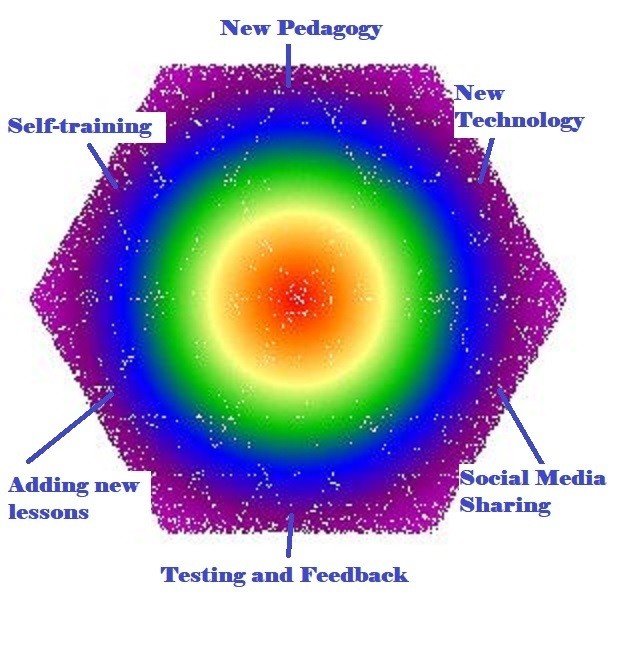English Skills: The 6 Facets Of Personalized Learning
I decided to elaborate on the recommendation given in this remarkable article:
"Yes, Personalized Learning is a lousy term, but it is attached to legitimate educational practices that have the potential to improve the lives of many students. It is also a term that is trapped in the early stages of its hype cycle. So let's just skip to the end and break Personalized Learning out of the hype cycle by doing our best to understand—and explain—what it really is and why it really matters".
The business models originally publicized by major language companies are collapsing, due largely to their student-consumers frustration over the lack of a system that allows for the quick acquisition of English fluency. Cengage, for example, was forced to go through bankruptcy. McGraw-Hill Education was sold to a private equity firm. Pearson's stock is near historic lows. Rosetta Stone laid off more than 1/6 of its workforce and closed its software development operations in China and France. All of these companies are obviously in desperate need of a new breakthrough technology, but they have so far provided only lip-service by jumping on the ‘Personalized Learning’ bandwagon before even understanding what that really means.
Personalized Learning, though popular as a pedagogical catch-all phrase, is, in fact, one of the most confusing concepts in education today. In defining our terms, then, Personalized Learning (PL) will hereafter refer to that method of learning which seems most immediately practical and useful to the student-consumer who is purchasing and practicing it to acquire fluency in English. Discussing PL without saying what subject or skill is learned does not make sense since, in each field, the PL would have a different framework, different features, and objectives.
PL is a term that sounds good without the inconvenience of having any obviously specific pedagogical meaning, so it becomes the flag that all vendors fly, even though in different fields it will have different structure and properties. I will limit discussion of PL to the field of learning English as a foreign language. As an example of the best-known company that had implemented its own version of PL, I have selected iTutorGroup.
According to iResearch, iTutorGroup is on track to be an $8.2 billion industry by 2019, thanks to the booming interest by Chinese people seeking to learn English for work and travel abroad. The company achieved this valuation mark by developing proprietary algorithms for PL used to match the right student with the right teaching consultant and digital content which ultimately increases the student’s learning performance and progress.
Frankly, I believe that these features of PL (as described on the iTutorGroup website), are just the tip of the iceberg in terms of what a truly successful PL technology could bring to students—not to mention what it would do for teachers! Below, I will describe my vision of PL implementation, and how this could be used to bring a fundamental change in the English proficiency of China and other countries which currently demonstrate low English proficiency.
The 6 Facets Of Personalized Learning Of English Skills
A successful implementation of PL in this area should begin with a new business model; thus, a new pedagogy and a new technology will be suggested here, fundamentally changing the way that current ‘PL’ teachers instruct their students. The teachers in PL serve as a "guide at the side" rather than a "sage on the stage" who just speaks at students.
Let’s stress again that PL should not be implemented with the conventional methods of teaching English for 2 reasons:
- Any teacher-centered approach—i.e. with lecturing as the main tool for delivering knowledge—is simply an inefficient way of becoming fluent in English and precludes any Personalized Learning.
- Conventional methods of learning English as a foreign language belong exclusively to the passive learning camp of instruction. These methods dissect the language into individual components (reading, listening, and speaking) and teach them separately.
The new pedagogy of Active Training in English skills, protected by 3 patents, is brain-compatible and ideally meets the requirements for PL. Active Training is a subconscious process that uses the human brain propensity to seek the patterns in the activity performed repeatedly so that this activity can be performed with a less conscious input. In Active Training all 3 skills—reading, listening and speaking—are trained simultaneously. The learner starts speaking actively before he or she remembers the rules of grammar or vocabulary lists (just like in real life conversation).
The New Technology emerges with the deployment of our mobile application for Active Training in English skills. This application is a revolutionary invention that must eventually replace any established competitor since its innovative features most fully satisfy the Personalized Learning habits of digital natives.
Our new mobile application successfully leverages these discussed PL principles to create the optimum environment for practicing all 6 facets of the Personalized Learning of English skills as shown below.
 Successful PL program implementation using this method should necessarily start by providing pedagogical and technological support to the PL teachers. Even certified and experienced English teachers should participate in brief re-training sessions or watch interactive videos which will allow them to master the new technology and new pedagogy of Active Training in English skills, both when using the mobile app and in the PL environment described above.
Successful PL program implementation using this method should necessarily start by providing pedagogical and technological support to the PL teachers. Even certified and experienced English teachers should participate in brief re-training sessions or watch interactive videos which will allow them to master the new technology and new pedagogy of Active Training in English skills, both when using the mobile app and in the PL environment described above.
This retraining starts by turning teachers into ‘coaches,’ who guide students to practice PL and participate in self-training using the same mobile application in the classroom, online or when assigning homework. Teachers, now freed from the task of lecturing, are able to give individual attention to those students who need it by answering questions and demonstrating how the PL of English skills should be practiced. They can also see how students are doing—both individually and as a class—through the software's Cumulative Analytics feature.
Now that we have covered the first 2 facets of PL in some detail (New Technology and New Pedagogy), we will move on to briefly discuss the other 4 principles underpinning a truly successful program.
Self-Training
From the consideration of the previous facets of PL we know that Active Training in English skills is a subconscious process, in which all English skills—reading, listening, speaking, pronunciation, and intuitive grammar—are trained concurrently. The act of speaking combined with reading the text and listening to the recording develops in the learner’s brain the language patterns and intuitive grammar which the learner after multiple repetitions and training drills uses without much effort, i.e. subconsciously.
The learning becomes active when each learner spends 80% of online or class time speaking in English. This looks like an impasse. How on earth could you have all learners speak all the time? No conventional method allows for that. However, introducing the patented mobile application and allowing all students to use their devices in the classroom or online study, we can achieve the unprecedented objective of learners practicing self-training according to their own pace, capabilities, and interests.
Moreover, the very same mobile application used for self-training in the classroom can be used for online courses or for assigning, planning, or turning in homework. Finally, the fun of our self-training mobile application means that further polishing of English skills will occur even after the formal PL course is completed.
Adding New Lessons
The mobile application allows learners or teachers to add to each prerecorded lesson the material of their own selection by copying and pasting (or manually entering) text and using the high quality, natural-sounding text-to-speech voices to perform the simultaneous repetition of the new material. Additional lessons can be added later by a student or a teacher, thus making the application interactive and suitable for vocational training.
For instance, this feature could easily be used to assign or post homework, but it could also be leveraged to help job-seekers prepare for interviews, or to help professionals plan presentations.
Social Media Sharing
Students naturally seek the help of other students. Because Personalized Learning practices make space for more interactivity, these practices often go hand-in-hand with active learning. And active learning is always social.
The learner’s speaking and self-testing are recorded, and they have the option of sharing it via social networking or by attaching it to an email for sharing with a teacher in the case of guided or Personalized Learning. The program automatically determines the learner's reading fluency and gives recommendations for improving reading and speaking skills.
No individual error correction is done in Active Training; the learners receive the feedback in the form of their fluency scores measured automatically during testing after each lesson. This is a more positive approach, and it shows better results than correcting individual errors. As one teacher noted: the learners keep making the same mistakes even after we’ve dealt with them a million times! Probably because correction reinforces errors and not the correct English—that should come exclusively from the learners’ experience.
Testing And Feedback
The mobile application uses a simple and ingenious method of testing the learner’s ability to speak automatically without thinking or translating from the mother tongue. Learners take a test after they complete each lesson by putting on earphones with a microphone and saying a few sentences on any topic from their past experience, prompted by the word that randomly drops down on the display from the word cloud. Learners use earphones with a microphone for self-training, PL, or guided learning to ensure high audio quality during simultaneous repetition and testing. The learner’s testing results are automatically recorded and used for evaluating progress in an active vocabulary and fluency score.
Built-in reading and speaking fluency tests, along with testing active vocabulary, provide gamification elements and keep the learner engaged. Responding quickly during tests helps learners develop the habit of automatic speech by pushing them to think directly in English. The testing strengthens students’ faith in the method and gives them a positive feeling of success. This same testing module of the mobile application should be also used at the beginning of the PL course and after the completion of it. It provides quantitative proof of the students’ progress as a result of the PL course.
Any real innovation turns myths into misconceptions! Active Training in English skills turns the myth that the only way to become fluent in English is speaking with native speakers into misconception. The ability to speak is a skill and not knowledge! Any skill should be trained. It is a misconception that to train conversational skills you need to speak with native speakers! In speaking you reinforce what you already know. To train conversational skills the learner needs the comprehensible multimedia input of Active Training. This type of input brings new word blocks to the learner which he first imitates and then after multiple repetitions will be able to produce automatically. This multimedia input is always comprehensible because support in the native language is built in the application.
Conversations with native speakers, offered by dozens of companies on the internet, do not have these input characteristics and on these grounds are less efficient than the PL described in this article.
When teachers and learners begin to interact together genuinely, they open the synergy process when the whole is greater than the sum of the parts. The capability of inventing new approaches is increased exponentially on both sides, among teachers and learners. This makes the PL interactive and self-regulated.
It is hard to grasp and follow the innovation: we need to see it to believe it. Both the recorded and the live demonstration of the synergy of the 6 facets of Personalized Learning of English skills are available.









